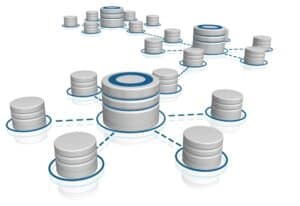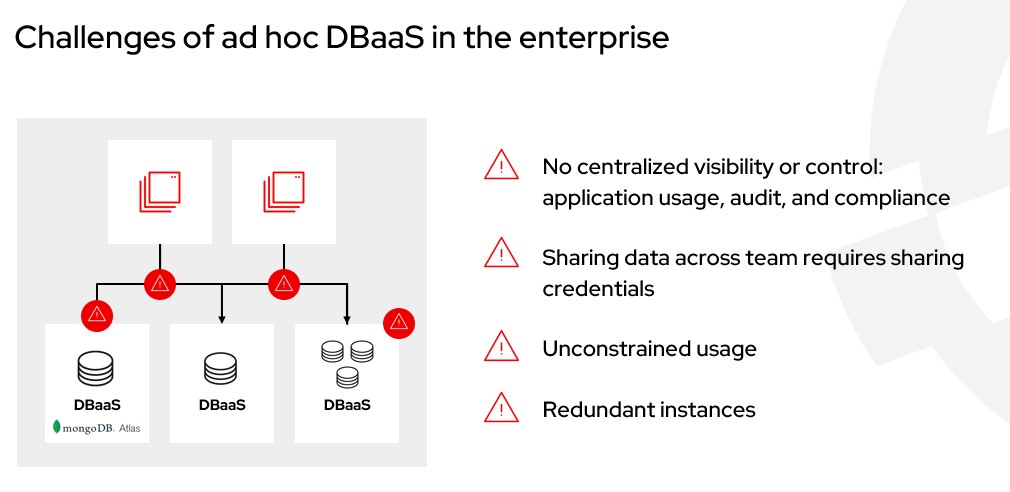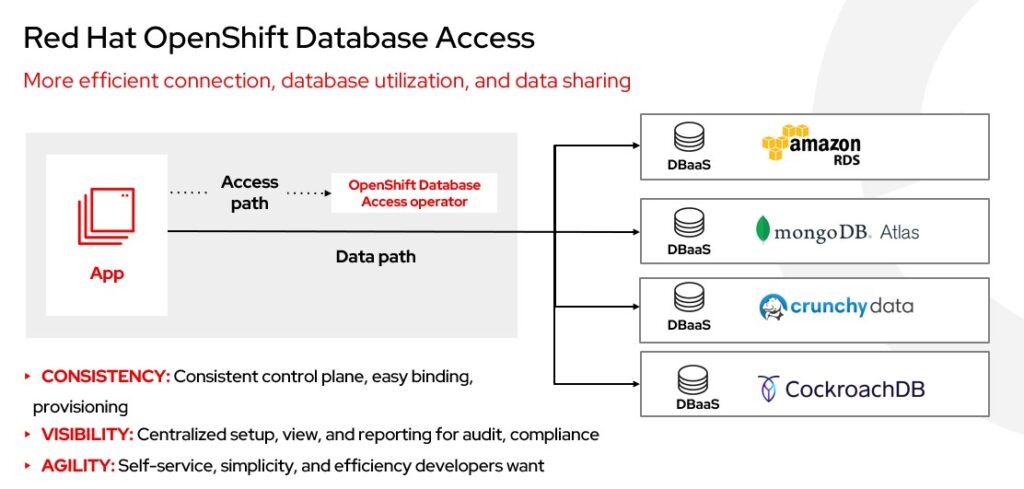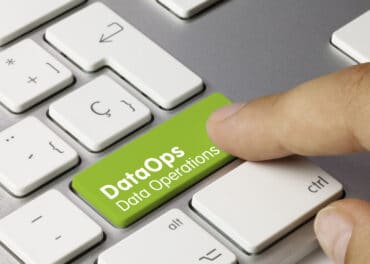
Managing database access can be a bane of many organizations developing modern applications. RHODA simplifies the process while offering the visibility, agility, and flexibility needed by ITOps, database administrators, and application developers.
Typical processes for providing access to databases often break down in modern development environments. Throughout an application’s lifecycle, there is a proliferation of different DB instances, each for various groups, including Dev, test, QA, production, and more. Database administrators are overwhelmed with requests for access credentials, application developers are frustrated due to the delay in getting started, and ITOps lacks the visibility into the processes needed for governance.
![Featured Resource: Simplifying Managed Database Access on OpenShift [Read Now]](https://no-cache.hubspot.com/cta/default/8019034/d144b842-ff5d-4d77-bcf6-54bb444f2d79.png)
What sometimes happens is that application developers, frustrated with the wait times for access, share their credentials with team members once access is granted. That raises security issues and leads to redundant and unconstrained use of database resources.
Why that’s the worst of all worlds
While there are many challenges to implementing databases and DBaaS for modern, cloud-native applications, one that continually pops up is handling access credentials.
All groups involved, including database administrators, IT Ops, and application developers, have different issues when it comes to providing and managing access. For example, database admins need to gain control over which developers access various database services. Developers need to create unique access configurations for each application and database they work on. And IT Ops needs control and visibility across all database offerings. These issues persist throughout the entire application lifecycle, including early-stage development, testing, deployment, and app updates.

Traditional approaches to providing access worked well when there were few new applications and updates, and development cycles were not so fast-paced. Today that is not the case, and there are additional complications. For instance, databases are no longer only on-premises and company-managed; in some instances, multiple databases are involved in an application development environment. Each of these factors makes database access a management nightmare.
Why? The common approach to providing database access is for each person or group that needs access to request credentials and privileges from that database’s administrator. What often happens is that people do not want to wait for the DB admin to address their requests. In many cases, those who have access share their credentials with colleagues. That is obviously a security protocol breach. But it also results in unconstrained and redundant use of DB resources. And there is no centralized visibility or control of app usage or compliance.
How Red Hat OpenShift Database Access can help
There are many ways a company might set out to implement a simpler database access solution to meet the needs of modern application requirements. But the last thing most companies need today is another do-it-yourself development effort.
Increasingly, an alternative is to work with a technology partner with a proven solution and expertise in the market. Enter Red Hat and Red Hat OpenShift Database Access (RHODA), which is designed to simplify and standardize how organizations provision, monitor, and connect to cloud-hosted partner database services across their environment.
Red Hat OpenShift already supports many databases, from self-managed cloud-native databases to DBaaS offerings from database vendors and cloud providers. RHODA simplifies access to managed cloud databases directly from OpenShift cloud services to help developers bring database-centric applications to production.
![Featured Resource: Simplifying Managed Database Access on OpenShift [Read Now]](https://no-cache.hubspot.com/cta/default/8019034/d144b842-ff5d-4d77-bcf6-54bb444f2d79.png)
RHODA lets administrators of OpenShift cloud services set up connections to DBaaS offerings from different providers in managed OpenShift Kubernetes environments. Developers get access via a self-service process. And administrators gain the centralized view and access control needed to manage many connections at scale.
Red Hat OpenShift Database Access leverages the Kubernetes construct of operators to bind applications to database instances. IT operations can launch a database discovery process based on resource permissions to identify the database instances that can be accessed. Once established by operations, developers can see those new database services from the catalog on their OpenShift developer console, represented as a UI tile for each database registered with the system. After selecting a database service instance, the developer can drag and drop a binding connector on the OpenShift developer UI to establish database connectivity to a Kubernetes pod. Self-service by developers from the free tier?

Red Hat OpenShift Database Access is a cloud service that is an extension to two OpenShift cloud services: OpenShift Dedicated and OpenShift Service on AWS. Initially, it supports a number of database cloud vendor offerings, including MongoDB Atlas, Crunchy Data’s Crunchy Bridge, Amazon RDS, and CockroachDB Dedicated.
These RHODA capabilities offer different benefits to different groups within an organization.
The value of using RHODA for ITOps leaders is that it centralizes database access visibility and control for all apps across multiple clusters, clouds, and vendors; increases developer productivity and reduces gatekeeping; reduces sprawl across DBs, clusters, apps, and processes; and improves performance while increasing speed to market.
Database administrators can monitor hosted DB access with consistent, standard, and simple connection information distribution across clouds and DBs in multicloud and hybrid cloud environments. RHODA also improves monitoring, governance, and control, all of which are needed to support compliance and audit requirements. And it helps avoid inefficient and redundant usage of database instances.
Application developers get self-service agility. RHODA lets them quickly, efficiently, and consistently connect to any database. They have the flexibility to experiment and access different databases. That allows them to focus on their code and on building apps, not on DB connections and credentials.
In summary, managing database access can be a bane of many organizations developing modern applications. RHODA simplifies the process while offering the visibility, agility, and flexibility needed by ITOps, database administrators, and application developers.
Learn more about RHODA here.






